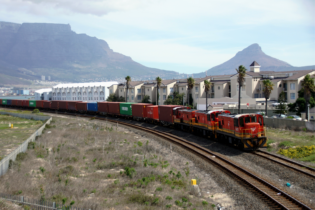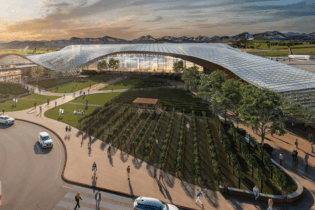Some view it as a sleeping giant, but the Eastern Cape has developed its own maritime industry over the years, which is set to become an economic power. Plans are afoot to invest substantial amounts into the region so the province can leverage off its ports as drivers of economic growth.
At the inaugural Eastern Cape Ports &Maritime Conference in Nelson Mandela Bay the areas port infrastructure was highlighted along with plans to invest in the three ports so the economy of the region can grow. Strategic challenges Karl Socikwa, CEO of Transnet Port Terminals, says: “The strategic challenges thathave to be overcome will entail a number of aspects being implemented and changed. There has to be a large-scale modal shift from road to rail to address costs, congestion and carbon emissions. “At present, both global and regional maritime connectivity is poor and we need a regionally integrated transport network, incorporating coastal transhipment. This will contribute to lowering supply chain costs for containerised goods and increasing regional overland and global maritime connectivity.” He adds that the regional freight system is weakly integrated and displays poor performance, which is why an integrated and aligned infrastructure network that provides capacity ahead of demand, allowing for supply chain optimisation at the network and industry level, is needed. “We also need to look at a low carbon freight system that will reduce vulnerability to the fluctuating international oil price and ensure long-term competitiveness and sustainability of the system.Also important is the ability of the state to retain strategic control of the network in order to lead and direct infrastructure investment and the development of the supplier industry.” Three ports Ayanda Vilakazi, the Coega Development Corporationhead of marketing and communications, says: “With three active ports in the province, the Eastern Cape is sitting on a goldmine of maritime resources and potential. The three ports – two in Nelson Mandela Bay and one in East London – play a complementary role and generally serve the hinterland.” Vilakazi believes that ports play a central role in the economic development of the province and provide a unique platform to sell the Eastern Cape to foreign investors. Coupled with direct linkages with the Coega and East London industrial development zones (IDZs), the offering is even more attractive and the Eastern Cape certainly has the ports and growing industrial prowess to fast-track development. “Currently Port Elizabeth centres on manganese ore exports as well as car exports and imports, containers and general cargo, and East London functions asa general port. Ninety per cent of manganese from South African mines is exported through the Port of Port Elizabeth, which also serves as the import and export destination for original equipment manufacturersbased in the city.” The Port Elizabeth and East Londonports are also positioned as automotive hubs as they service General Motors South Africa, Volkswagen South Africa (VWSA) and Mercedes-Benz. The Port of Ngqurais a strategictranshipment hub for containers, but is now gearing up to export an initial amount of 16 million tonnes of manganese per annum in 2017 and will later ramp this figure up based on demand. States Vilakazi:“The integration of the three ports is work in progress, although informed by specific roles for each of the three ports, with some common areas of functionality.Since they serve different purposes generally, all three ports are essential, particularly when it comes to attracting and retaining investment. Mercedes-Benz and VWSA would pull out of the cities they are based inif the ports were downgraded or closed, showing the strong linkages between economic development and access to ports. “The whole concept of IDZs – and the emerging landscape of special economic zones SEZs – requires a fully integrated landside-seaside development and hence the Coega IDZ needs the Port Ngquraand vice versa; similarly the East London IDZ needs its port. This is what is meant by the ‘full integration and co-dependence’ we are working towards in the province and at the conference as an initial start point for greater collaboration within the maritime industry.” Ports are under pressure to keep up with the growing size of vessels, and the development of the deep-water Port of Ngqura was specifically geared to accommodate new generation container ships and large bulk carriers.Nelson Mandela Bay is unusual in that it has two ports. The Port of Ngqura is complemented by the Port of Port Elizabeth.
“Major economic growth is derived from increased employment for the region and the fact that local manufacturers are able to export their goods through the ports,” says Vilakazi. “As containerisation continues, so does the drive for greater efficiency.Ports will remain key nodes in global logistics chains for the foreseeable future, but seamless integration with landside operations – rail for long haul and road for short haul – is also critical.Coega is working with provincial government on roads and other infrastructure projects as an enabler for the economic development of the Eastern Cape. “There are some major projects on the horizonand ports are key enablers in logistics chains with an increasingly global reach.Most investors interested in the Coega IDZ are interested because of the close proximity of the new deep water port. “Without such linkages, key investments such as General Motors’ pan-African distribution centre, all the wind projects, FAWand Phyto Energy would never have taken place. Likewise, all the coming investments – Project Mthombo, the Ferro-manganese smelter and others – would not have been a reality had there not been the vision and will to build another provincial port thathas the capacity to handle big projects. “Without this push for the new Port of Ngqura, we would not have increased trade in the province –trade that generates jobs.” Capital investment Over the past five years,Transnet Port Terminals has invested in the port infrastructure and will continue to do so over the next few years having set aside R6.7 billion for the Eastern Cape. Between 2009 and 2013, R1.578 million was invested on expanding the Ngqura Container Terminal and a total of R718 million was spent on the PE Manganese expansionbetween 2009 and 2011.In 2012, R17 million was invested into the East London grain elevator and R210million was spent on 10haulers and trailers. In 2013 R44 million was spent on a mobile harbour crane at East London. Over the next few years Transnet Port Terminals plans to invest R6.7 billion on the following: • increasing the manganese throughput to 5.5 million tonnes from the current output of 4.8 million tonnes. • relocate the manganese facility to the Port of Ngqura • develop a coal handling facility at the East London Terminal, which will handle 2 Mtpa of coal from 2017/18 • expand the Ngqura Container Terminal from its current 800 000 TEU capacity to 1.5 million TEU • replace the straddle carriers in PE.







